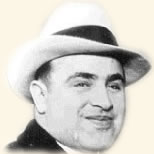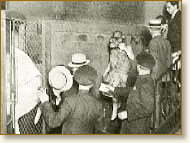Prohibition
 |
Chicago gangster Al Capone
Bootlegging made him a
millionaire and top dog
of the Mob |
The 18th Amendment to the Constitution prohibiting the manufacture, sale, or transportation of alcohol in America went into effect on January 16, 1920. The United States was now officially "dry" from coast to coast. Prohibition was the law of the land.
The advocates of Prohibition had waged a 50-year campaign to ban alcohol and
had high hopes for this "The Noble Experiment." Supporters
anticipated that alcohol's banishment would lead to the eradication of poverty
and vice while simultaneously ennobling the common man to achieve his highest
goals. The reality of Prohibition was to prove quite different.
For the next fourteen years much time, money and manpower would be devoted to enforcement, however, the task was impossible. "Rum fleets" filled with liquor from Europe appeared off the Atlantic coast. As many as sixteen ships at a time would lie at anchor just outside U.S. territorial waters while smaller boats made the run to safe harbors. The Canadian border was a sieve through which liquor easily flowed. Clandestine distilleries grew like mushrooms in the city and countryside alike. Speakeasies flourished and the liquor flowed, even finding its way
 |
Busted - A raid on a speakeasy
New York City, 1925 |
into the White House during Harding's administration. Alliances between politicians and gangsters assured the public would not want for alcohol.
By 1926, it was apparent the Noble Experiment was not working. Polls indicated
the majority of Americans favored the repeal of the 18th Amendment. Repeal
was not to come until 1933. The end was quick. On February 20, 1933, Congress
proposed the 21st Amendment to the Constitution repealing the 18th Amendment.
On December 5, Utah became the thirty-sixth state to vote for ratification
assuring acceptance of the 21st Amendment. Prohibition was dead.
References:
Coffey, Thomas, M., The Long Thirst: Prohibition in America 1920-1933 (1975)
How To Cite This Article:
"Prohibition," EyeWitness to History, www.eyewitnesstohistory.com (2000).
|






